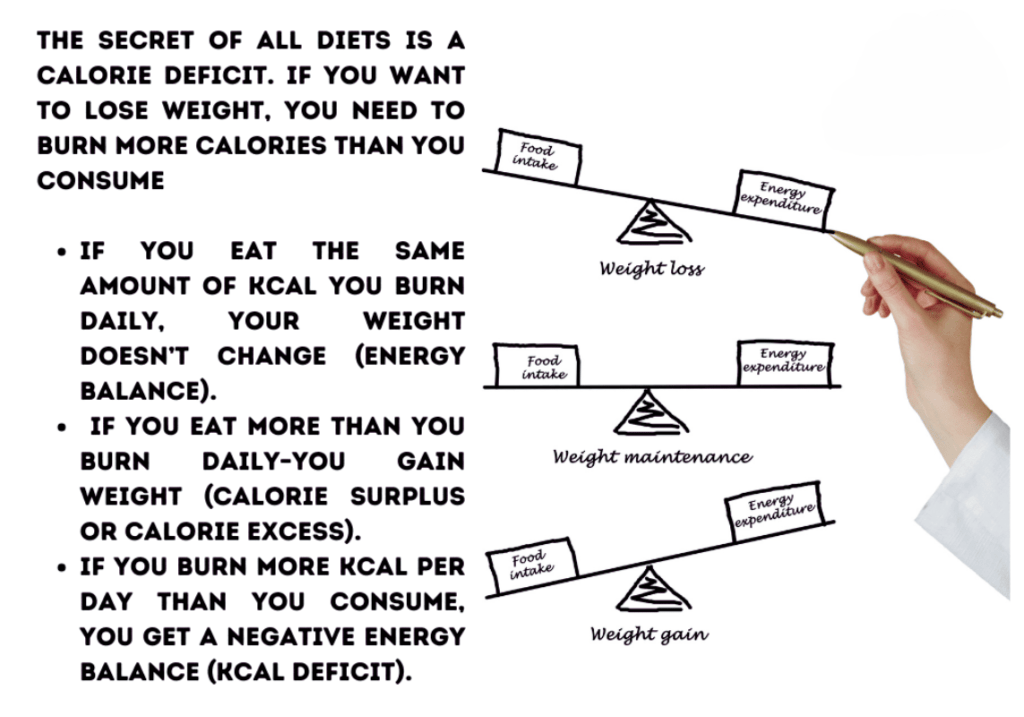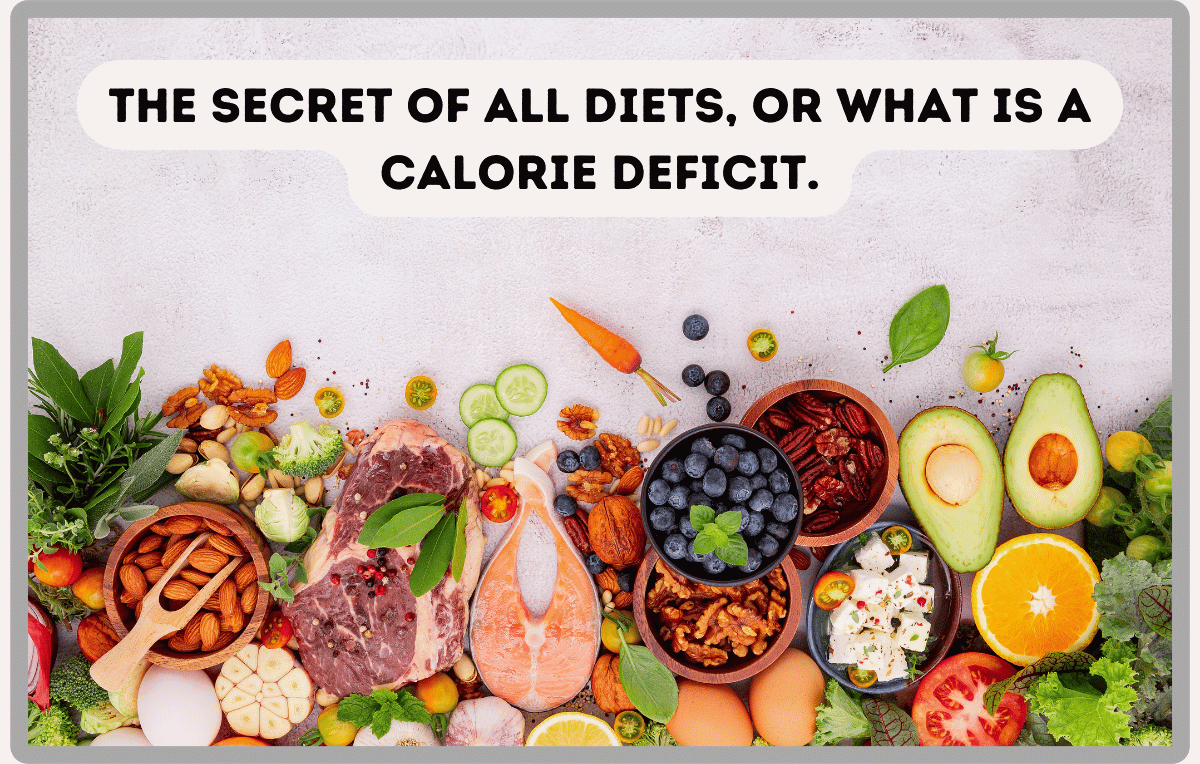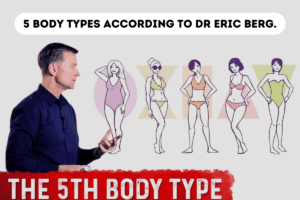When you want to lose weight, you start searching the internet for a diet. But what diet is the best for losing weight? Is it an intermittent fasting diet, Plant-based diet, Low-carb diet, Paleo diet, Low-fat diet, Mediterranean diet, or something else? Actually, it doesn’t matter what diet you use to lose weight, because they all have the same principle: “If you want to lose weight, you need to burn more calories than you consume”. In other words, the secret of all diets is a calorie deficit. Now, let’s discuss it a little bit more.
Each bite of food you eat contains energy in the form of calories. 1 gram of carbohydrates provides us with 4 kcal, 1 gram of protein = 4 kcal, and 1 gram of fat = 9 kcal. You need to consume calories for your body to function correctly. But most of us consume more calories than we need each day. This creates a calorie surplus or calorie excess. The extra calories are stored as fat. To start losing fat, you must eat fewer calories during the day than your body needs.
When you create a calorie deficit, your body gets energy or fuel from stored fat. This is the extra fat that you carry on your hips or thighs, in your belly, and throughout your body. Stored fat is a stored energy. Your body can use it to keep moving instead of using energy from food. When your body burns fat for energy, you lose weight.

Everything I wrote above, is also called energy balance (Example is in Picture No. 1 below). Energy balance is simply the relationship between your energy input and output. Energy input is the amount of kcal we get with food. Energy output is the amount of kcal that we burn per day. If you eat the same amount of kcal you burn daily, your weight doesn’t change (energy balance). If you eat more than you burn daily–you gain weight (calorie surplus or calorie excess). If you burn more kcal per day than you consume, you get a negative energy balance (kcal deficit). Now you should understand this secret. All you need to do is just burn more calories than you consume. And for this purpose, you need to know how much food you are eating (energy input), and how much energy you are burning per day (energy output). Everything else is just mathematics. Now, let’s look at how many calories you burn daily (energy expenditure).
How many calories are you burning per day (energy output)?
Different people need different amounts of energy. It all depends on weight, age and activity level, which vary considerably. There are different methods to calculate our body’s energy needs, but I will show the easiest one. Energy expenditure (how much energy our body needs) = (BMR) Basal metabolic rate * PAL (Physical activity level). Physical activity is all activity, including eating, working, and driving (everything we do daily). PAL is based on what kind of job and leisure activities you have (Table No2). Basal metabolic rate (BMR) is the minimum amount of energy our body uses to maintain essential bodily functions like breathing and our heartbeat.
Firstly, let’s calculate our BMR. The method used to estimate BMR in kcal of the average healthy adult man and woman is the Schofield equation (Table No.1), which considers age, weight and gender. BMR contributes around 75% of the total energy expenditure.
Table No.1 The Schofield Equation
| BMR (Kcals/day) | ||
| Age | BMR male | BMR female |
| 10-17 years | 17.7xW+657 | 13.4xW+692 |
| 18-29 years | 15.1xW+692 | 14.8xW+487 |
| 30-59 years | 11.5xW+873 | 8.3xW+846 |
| 60-74 years | 11.9xW+700 | 9.2xW+687 |
W = weight in Kg.
For example BMR of a 29 years male would be: 15,1*85 (lets say his weight is 85kg) + 692= 1975,5 kcal.
Table No.2 Physical activity level (PAL)
| Non occupational activity | Occupational activity | |||||
| Light | Moderate | Heavy | ||||
| M | F | M | F | M | F | |
| Non active | 1.4 | 1.4 | 1.6 | 1.5 | 1.7 | 1.5 |
| Moderately active | 1.5 | 1.5 | 1.7 | 1.6 | 1.8 | 1.6 |
| Very active | 1.6 | 1.6 | 1.8 | 1.7 | 1.9 | 1.7 |
Next, let’s calculate energy expenditure. For example, if your non-occupational daily activities are very active (we exercise 5 days per week in the gym), occupational activity is light, and you are a man, your PAL number is 1,6. In this case, Energy expenditure = 1975,5 kcal (BMR)*1,6 (PAL) = 3180,8 kcal/day. This is the amount of kcal you need per day. If you are eating less calories, you are losing weight. If you are eating more calories, then you are gaining weight. Simple as that.
How many calories are you getting per day (energy input)?
When you know how many calories your body burns daily, you must calculate how much food you eat daily. It is essential to do, because if you don’t know how many calories you eat daily, how will you create a calorie deficit?

The best way to calculate food is to count calories, which is not as difficult as you think. Nowadays, we have different fitness apps where you can easily calculate the calories you consume. One such programme is the MyFitnessPal app, which can do all the work instead of you. I suggest you buy this program (it’s not expensive) and have a try. The program is very easy and comfortable to use. You can plan your meals using a computer or your smartphone. And I especially like their barcode scanner. You just scan the barcode on the product, and the program shows you how much protein, fat, and carbohydrates you will get with this food. You will also need kitchen scales and measuring glasses or bowls for cereals and liquids to calculate calories. You can get more information about the MyFitnessPal app and how to use it just by watching some video explanations on YouTube.
Also, there is one more method to control the amount of food you eat. All you need to do is eat every day the same meals and the same portions of these meals. In this method, you still need to calculate how much food you eat, but now, instead of calories, you are counting grams (how many grams of food you eat). After some time, you will know precisely what you will eat for breakfast, lunch and dinner and the exact amounts of food in grams. You will know how much porridge or pasta you need for your meals. And on this stage, you can stop counting calories and start counting everything just in grams. It will be much easier. So, I suggest starting by counting calories using MyFitnessPal because it’s also essential to know how much carbohydrates, protein, and fat you use. After you create a proper meal plan using MyFitnessPal, you can move to count just grams of your food.
The Proper Calorie Deficit to Lose Weight
It can look easy to create a calorie deficit. We could eat fruits and vegetables or drink water and lose weight. But in reality, it is not so simple. You need to create a specific energy deficit for weight loss to happen. If you decrease the number of calories too much, you will not get enough vitamins and minerals from food for your body, your metabolism will slow down and your body will start burning muscles to get energy.
A proper and safe calorie deficit must be not more than 500 kcal a day. This will help you to lose 0.5 kg per week (Safe weight loss is 0.5 – 1 kg per week). To understand better what I am talking about, let’s create an example. Let’s take again a man whose BMR is 1975,5 kcal. and his Pal is 1,6. So, for him, Kcal deficit = 3180,8 kcal/day – 500kcal = 2660,8 kcal. This is the amount of calories he needs to consume to lose weight.
3 ways to create a kcal deficit.
There are three ways you can create a calorie deficit. First, you can decrease the amount of food by 500 kcal. The second option is to increase physical activity and burn 500 kcal more. The last option is a combination of both – decrease 250 kcal from food and increase physical activity to burn an additional 250 kcal.
All these methods work like these. Step one, you make a 500-kcal deficit and continue to maintain this deficit all week. Secondly, at the end of the week, you take your body measurements (use measuring tape and scales). If weight decreased by over 1 kg, you made a kcal deficit too big. If weight decreases to 0.5 -1 kg, you are on the right way. If weight doesn’t change, increase the kcal deficit. It is that simple.
P.S. Interesting fact
In 1995, Dr S. Jebb and Dr A. Prentice undertook a study that looked at what had happened to fat, energy intake and energy expenditure over the last 50 years to establish why there is now an obesity epidemic in the UK. What do you think they found out about fat intake over the last 50 years? Surprisingly, they found that fat and energy intake decreased over the past 50 years. And as to energy expenditure, it also went down. This means that the reason why obesity increased nowadays is not because we started overeating but because we have become less active.

If we look around, it’s obvious. Modern life in the Western world has been made much more accessible, leading to population changes in energy balance. Increased mechanisation and modernised technology in our environment have made us less active. The combination of computers, email, and video phone communication means we don’t have to walk to see a colleague or move offices for a meeting. We can do it all at our desks. Escalators and lifts mean we no longer need to use the stairs, so we exercise less. Washing machines and tumble dryers, kitchen and other home gadgets do the jobs we used to do ourselves physically. Our decrease in activity has meant the energy balance equation is tilted more towards higher energy intakes than our total energy expenditure. We are doing less activities but not consuming less food. Think about that.
In this article, we were speaking just about losing weight. We didn’t speak about what healthy eating is, what products are better for your diet, etc. More about healthy eating, you can read in my article: “How to eat healthy or what is a balanced diet?”. Also, for more information about losing weight, read my article “Your step-by-step weight loss program”.
Conclusion of this article:
- To start losing fat, you must burn more calories than you consume. You just need to calculate somehow the number of calories you eat and the number of calories you burn daily. Everything else is just mathematics.
- The best way to calculate calories is to use the MyFitnessPal app. It’s very easy to use, but if you need extra help, just go to YouTube, and text the MyFitnessPal tutorial.
- To understand how many calories your body needs, multiply BMR * PAL. An example is above.
- Proper and safe calorie deficit must be not more than 500 kcal a day. This will help you to lose 0.5 kg per week. Safe weight loss is 0.5 – 1 kg per week.
- We now have an obesity epidemic in the UK because of decreased activity. We are doing less activities but not consuming less food.





Pingback: Why is it important to be active during the day, or what are the benefits of daily physical activity? - AnatolijFitness